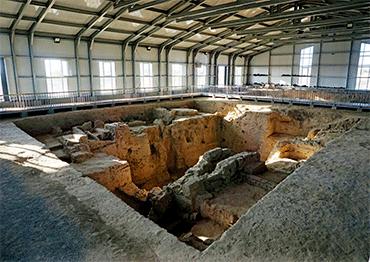Wang, 70, first visited Central Asia over a decade ago, just as a tourist. At that time, no Chinese archeological team had ever conducted an international dig. In the years since, he has visited most of the major sites in the region, in pursuit of his passion – proof of the fate of a loose nomadic tribe known as the Yuezhi, who lived in northwest China in the first millennium BCE.
The first recorded mentions of the Yuezhi come in the Records of the Grand Historian by Han historian Sima Qian, written around the late 2nd century BCE, and the Book of Han, finished in the year 111. The accounts place the Yuezhi around the Hexi Corridor, in today’s northwestern Gansu Province.
In the 2nd century BCE, the Yuezhi were attacked and defeated by a nomadic tribe called the Xiongnu, living in what is roughly Mongolia today, and considered to be the forebears of the Mongolian people. Initially the stronger group, in 176 BCE the Yuezhi suffered a huge defeat at the hands of the Xiongnu. The survivors split into two groups and set off on a westward migration. The larger group – the Greater Yuezhi – went to Central Asia, and the Lesser Yuezhi trekked southwest to the edge of the Qinghai-Tibet Plateau. Their arrival in all areas displaced existing tribes, especially in Central Asia, and changed the course of history.
In 138 BCE, the seventh Han Emperor Wudi (156 BCE–86 BCE) dispatched envoy Zhang Qian to search for the Greater Yuezhi in the west, hoping to unite with them against the Xiongnu. Returning to the Han capital of Chang An (now Xi’an) in 126 BCE, he reported that the Yuezhi were no longer interested in fighting the Xiongnu. Yet, his mission was not a failure. He went as far as Bactria, which had been part of the ancient Persian empire, located in northern Afghanistan and southern Uzbekistan. He brought back information on the new lands, and the impact of his trip echoed down the ages, initiating the emergence and formation of the Silk Road from China to the Mediterranean region.
The Greater Yuezhi settled in Central Asia and regained their strength, displacing already settled tribes. They continued to communicate with the Han. While 17 bamboo slips excavated in the 1990s from the Xuanquanzhi Ruins, an ancient posthouse in Gansu Province, mentioned the Greater Yuezhi, not much hard evidence of them or the route of the Greater Yuezhi Westward Migration has ever been found.
Serious research on the Greater Yuezhi in Central Asia only began in earnest in the last 50 years, at first by researchers from Europe, the US and Japan. Wang Jianxin, who first heard about the Yuezhi from visiting Japanese archaeologist Takayasu Higuchi in 1991, has made it his life’s work to uncover the mystery, first by tracing their route in western China, then expanding the search to Central Asia.
The Tianshan Mountains cross the Eurasian continent, spanning China, Kazakhstan, Kyrgyzstan and Uzbekistan from east to west. More than two-thirds are in Xinjiang Uygur Autonomous Region, the Eastern Tianshan, with the Western Tianshan range extending across Central Asian countries.
In the 2000s, Wang concentrated on investigating western China, pioneering research into ancient nomadic tribes, and discovering hundreds of settlement sites, upending the notion that nomadic tribes were always on the move.
After the China-led Belt and Road Initiative kicked off in 2013, with an announcement by Chinese President Xi Jinping in Kazakhstan, funding for international digs became available to Wang. By the end of 2013, Wang was cooperating with the Institute of Archaeology at Uzbekistan’s Academy of Sciences and had established a joint Sino-Uzbek team to investigate sites in the Western Tianshan.
In 2015, his team finally found an ancient site they concluded belonged to the Kangju some 20 kilometers southwest of Samarkand in Uzbekistan. There they found six tombs and inhabited sites believed to belong to the nomadic Kangju tribe, regarded as the second-most important after the Yuezhi. The discovery, which was a sensation among international researchers, allowed archaeologists to shift the area of research to the south as the Kangju were thought to have lived north of the Yuezhi.
At the end of 2016, the Central Asian Archaeological Team were researching the Surkhan Darya area, the most southerly part of Uzbekistan. On the last day, Liang Yun, the excavation leader and a professor at Northwest University, noticed a gray ashy soil layer in the riverbed. Using his trowel, he sifted the soil, unearthing a human bone. It belonged to an ancient tomb. They had found the Rabat site in Boysun city, Uzbekistan.
The Rabat site is located in the northern Bactria area between Uzbekistan and Tajikistan, and the Greater Yuezhi were the dominant tribe there. The lands were formerly the Greco-Bactria Kingdom after Alexander the Great conquered it in 329 BCE.
Due to the work conducted by the Central Asian archaeological team, the ancient Central Asian territories that Zhang Qian visited were found and confirmed. Apart from these archaeological achievements, Chinese archaeologists have set up cooperative ties with their counterparts in Central Asian countries. The building up of mutual trust between and among the various sides in Central Asia promote joint archaeological efforts in a wider platform.

 Old Version
Old Version



